
 Translate
Translate
-
* News
- - Agira 2018, 75 years later
- - Agira 2013, 70 years later
- - Gallery of ceremony 2013
- - Operation Husky 2013
- * Students' Contribute
- * About Us
- * Visitor's Book
- * Collaborators
- * Canadian Battles
- * Italian Defensive Positions
- * Allied Forces
- * Historical Movies
- Historical Information
- Historical Maps
- * Bibliography
- Biographies
- * Catania War Cemetery
- * Moro River War Cemetery
- * Syracuse War Cemetery

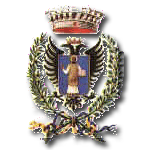


Regalbuto was a Battle Honour granted to two Canadian infantry regiments that fought at that town from 30 Jul to 3 Aug 1943 during the Battle of Sicily, a phase of the Italian Campaign during the Second World War.
The Hermann Goering Division's operations order of 27 Jul 1943 stated clearly that Regalbuto was to be held, and with Centuripe formed the main defensive outpost in front of Adrano, itself the key position of the Etna defensive line.Generalmajor Paul Conrath, commander of the division, felt this right flank was the key to his entire defensive line.
To strengthen his flank, Conrath ordered the Hermann Göring Armoured Engineer Battalion to take over the defence of Regalbuto and to retain or take under command a squadron of tanks and certain sub-units of artillery. The Armoured Engineer Battalion, which had previously formed part of one of the Division's battle groups (Kampfgruppevon Carnap), now came directly under Conrath's command. For the first time since their encounter at Grammichele the Canadians were to meet the Hermann Görings again.1
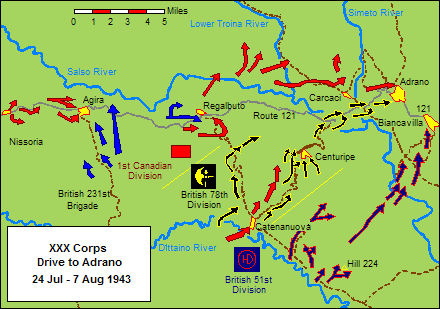 Further orders by the engineer battalion the same day as the divisional operations order "reminded the battalion that enemy action had 'hitherto not forced a withdrawal to a new line."2
Further orders by the engineer battalion the same day as the divisional operations order "reminded the battalion that enemy action had 'hitherto not forced a withdrawal to a new line."2
The garrison at the time of the battle consisted of eight tanks, a battery of artillery, an infantry company of Parachute Regiment 3, and "a few rocket launchers (Nebelwerfern)." Conrath, exercising personal command of the garrison, ordered the defence hold at all costs.3
From the 2000-foot peak of Mount Santa Lucia, which marked the summit of Regalbuto Ridge, the Germans could completely dominate the eastern and southern approaches to the town. Regalbuto, built 1600 feet above sea level, lay at the convergence of three prominent hill features. South-west ran the mile-long Regalbuto Ridge; the the north-west a somewhat longer spur bearing the name Mount Serione projected about the same distance into the Salso valley; and to the east, separated from Santa Lucia by a deep ravine which admitted the road from Catenanuova, rose almost precipitously "Tower Hill", the western extremity of the great barrier of heights reaching over to Centuripe.4
The battle for Regalbuto drew near as the 1st Canadian Division moved through almond and olive groves on 28 Jul to within one mile of the town. In the early morning of the 30th, British 231st Infantry Brigade was hit by German rocket fire on their Start Line. Pushing on despite heavy casualties, the brigade was ambushed by German paratroopers and armoured engineers, and forced to fall back.
As night fell (on 29 Jul, the Hampshire Regiment) received orders to launch an attack against a long ridge which stretched south of the highway within a mile of Regalbuto. Unlike most of the other ridges in the area, this one ran parallel to the road, which it commanded along its entire length. On this rocky rise the Hermann Göring Engineers had decided to make their stand to prevent or delay the capture of Regalbuto, a fact of which the Hampshires became unpleasantly aware when a wicked burst of nebelwerfer fire met them as they formed up on their start line. One platoon was practically wiped out. In spite of this inauspicious beginning the battalion pressed on bravely, only to be caught in the deadly cross-fire of machine-guns. In the face of rapidly mounting casualties and a realization of the enemy's numbers, the attack was called off.5
The ridge overlooking Regalbuto would not fall until 0235hrs on 31 Jul "after a severe series of firefights."6 With the enemy in control of Santa Lucia and Mount Serione, entry into the town on Highway No. 121 was impossible.
The naturally strong Regalbuto ridge was covered by troops on the nearby Tower Hill and Monte Tiglio. The approaches were treacherous, necessitating the crossing of numerous steep ravines and rocky spurs. The 231st Maltese, who had moved into position after a very tough cross-country approach, launched the attack on the night 30-31 Jul.7
The 2nd Battalion of The Devonshire Regiment went forward late on 30 Jul, executed a flanking attack, and with the supporting fire of 144 guns from four field (1st RCHA, 2nd RCA, 3rd RCA, 165th RA (British)) and three medium (7th Medium RA, 64th Medium RA and 70th Medium RA) artillery regiments, seized the hill. Counterattacks by the Hermann Görings as well as Parachute Regiment 3 failed to dislodge them, though 109 officers and men of the Dorsets became casualties. During the late morning of the 31st, the Dorestshires attacked Mount Serione, with one company capturing an uncompleted railway station and another company gaining possession of a cemetery defended by the Germans. By late afternoon, the Dorsets dominated two roads leading into Regalbuto from the north and the northwest. The 48th Highlanders, placed temporarily under command of the 231st Brigade, relieved them before dusk.
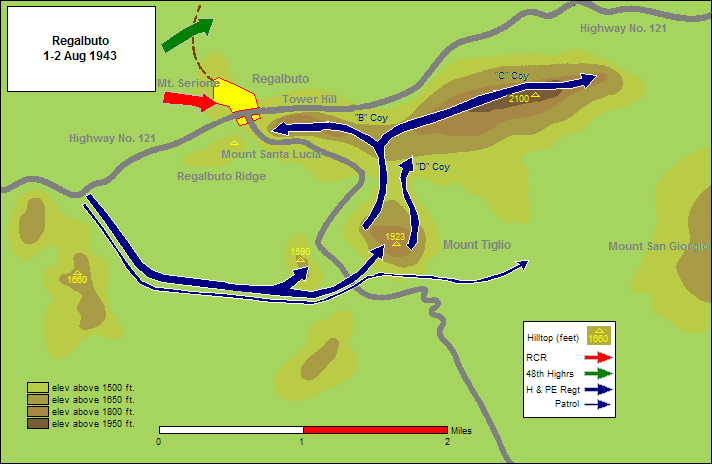
Conditions here were not unlike those at Nissoria, for the real strength of Regalbuto lay in a commanding ridge beyond the town, and in two flanking hills to the south. Here the enemy...sat firmly in position and no amount of frontal battle could dislodge him.8
The Royal Canadian Regiment launched a night attack on Tower Hill on 31 Jul after a six mile approach march followed by a hasty reconnaissance. The failure to secure the Start Line was also problematic, and after a delayed start the assault companies attacked into a steep ravine. Halted by heavy fire, the RCR were trapped at daybreak and left under a hot sun with no food or water. A withdrawal came only under the cover of darkness that night.
Also after last light on 1 Aug, The Hastings and Prince Edward Regiment launched an attack, this time with a proper reconnaissance, and moved from hill to hill arriving at dawn to attack Tower Hill.
...when the (Hastings and Prince Edward Regiment) was ordered to attack during the night of August 1, it was given a free hand to do the job in its own way. The Regiment, too, had learned a lesson and the new CO, Major A.A. Kennedy, was a mat to profit by experience.
Regalbuto was to be no buccaneering rush into the unknown - the sort of thing that had brought renown at Assoro, and disaster at Nissoria - but, as far as the CO could make it, this battle was to be a carefully calculated action. Kennedy started by sending long-distance patrols far to the east with orders to penetrate deeply into the enemy's flank and report his dispositions, and the best routes of approach. The CO himself, with his company commanders, then carried out a detailed reconnaissance, and laid the battle plans with care and caution. The operation was to be a wide right flank attack, but not a blind one. Nor would it be unsupported. The artillery FOOs were ordered to travel with the CO, and the mortar platoon was ordered to come along on foot, and manhandle its heavy weapons and ammunition over the five miles of the approach march.9
The companies moved over rough terrain, but the advance patrols were able to provide guides and the movement went smoothly with their assistance, as well as the battalion scouts. Both "A" and "B" Companies crested Mount Tiglio, the southern bulwark of the defences at Regalbuto, finding fresh weapons pits but no Germans. Three days of battle had possibly convinced the Germans no attacks would come from the south.
Major Kennedy realized as dawn broke that a premature attack would be disastrous. He gave his mortar crews time to establish themselves, allowed his company commanders time to assess the ground for the attack on Regalbuto, and permitted the FOOs to survey the terrain and report on likely enemy concentrations.
At noon on 2 Aug, "D" Company attacked across the broad valley as a diversion, firing from more than ten separate positions. "D" Company went to ground as planned and held the attention of the Germans. As the enemy exposed their weapons positions to fire on the company, 3-inch mortar fire and artillery was called down to neutralize them. "B" and "C" Companies were able to cross the valley practically unopposed and attacked up onto the heights opposite Mt. Tiglio. The heights were cleared within thirty minutes, capturing machine gun positions and driving the Germans off.
A patrol of the 48th Highlanders simultaneously entered Regalbuto itself, to find the enemy there had left.
- By eight o'clock in the evening the (Hastings and Prince Edward Regiment) was in firm possession of the ridge. The last enemy stronghold on the road to Adrano had fallen.10
After the battle, the 1st Canadian Division continued the drive eastwards, down the beds of the Salso and Troina rivers. The 1st Canadian Brigade went into a rest area on 7 Aug. For the Hastings and Prince Edward Regiment, according to regimental historian Farley Mowat,
- The capture of Regalbuto was a fitting conclusion to an arduous apprenticeship. In twenty days the unit had been well blooded and hardened into a superlative machine for battle.11
For the inhabitants of the town, the battle had grimmer consequences:
- When the Canadians entered Regalbuto on the heels of the occupying troops of the Malta Brigade, they came upon a scene of destruction far more extensive than any they had previously encountered in Sicily. The town had received a full share of shelling and aerial bombardment, and hardly a building remained intact. Rubble completely blocked the main thoroughfare, and a route was only opened when engineers with bulldozers forced a one-way passage along a narrow side-street. For once there was no welcome by cheering crowds, with the usual shouted requests for cigarettes, chocolate or biscuits. The place was all but deserted; most of the inhabitants had fled to the surrounding hills or the railway tunnels. They were only now beginning to straggle back, dirty, ragged and apparently half-fed, to search pitifully for miserable gleanings among the debris of their shattered homes.12
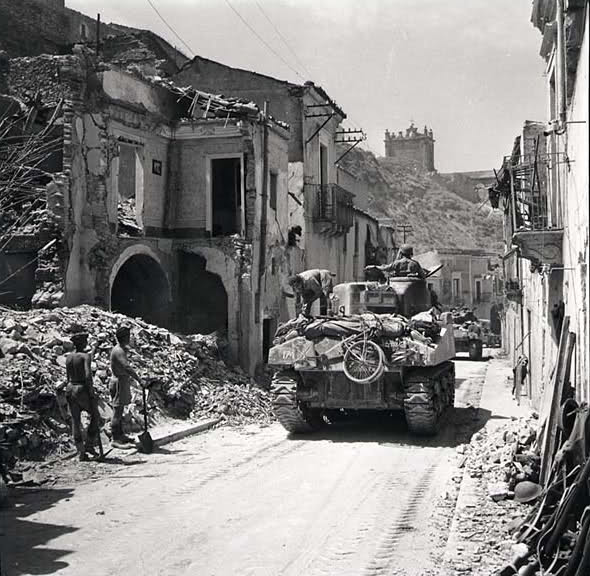 |
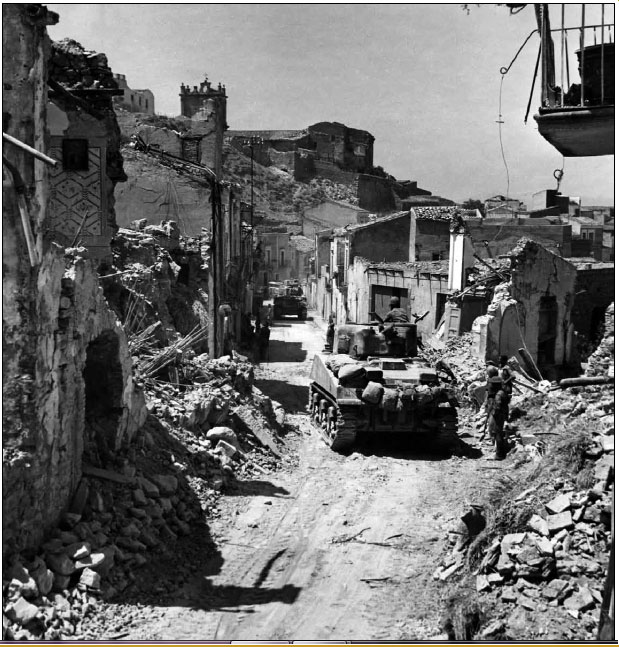
|
Tanks of the Three Rivers Regiment enter the remains of Regalbuto after the battle. LAC photos |
|
The following Canadian units were awarded the Battle Honour "Regalbuto" for participation in these actions:
 1st Canadian Brigade
1st Canadian Brigade
-
The Royal Canadian Regiment
-
The Hastings and Prince Edward Regiment
- Nicholson, Gerald. Official History of the Canadian Army in the Second World War. Volume II: The Canadians in Italy, 1943-1945 (Queen's Printer, Ottawa, ON, 1957) p.146
- Ibid, p.146
- Mitcham, Samuel and Friedrich von Stauffenberg The Battle of Sicily: How the Allies Lost Their Chance for Total Victory (Orion Books, New York, NY, 1991), p.239
- Nicholson, Ibid, pp.147-148
- Nicholson, Ibid, p.147
- Mitcham, Ibid, p.239
- Mackay, A. Donald Gaudeamus Igitur "Therefore Rejoice" (Bunker to Bunker Books, Calgary, AB, 2005) ISBN 1894255534 pp.62-63
- Mowat , Farley. The Regiment (McClelland & Stewart Inc., Toronto, ON, 1955) ISBN 0771066945 (paperback edition) p.135
- Mowat, Ibid, p.132
- Nicholson, Ibid, p.152
- Mowat, Ibid, p. 132
- Nicholson, Ibid, p.152



